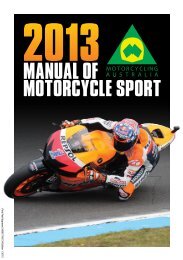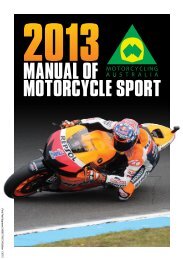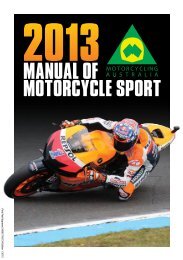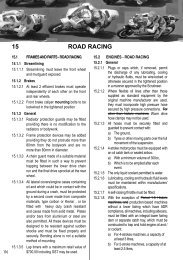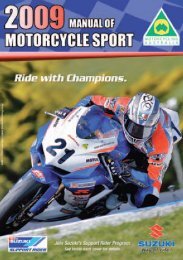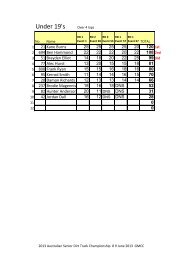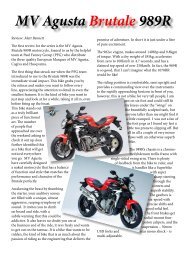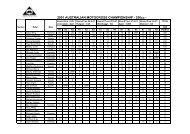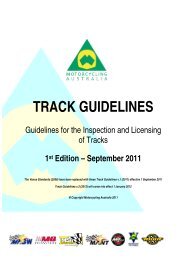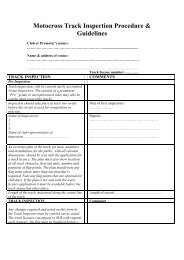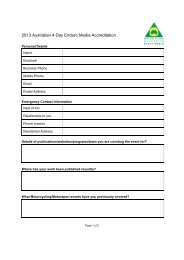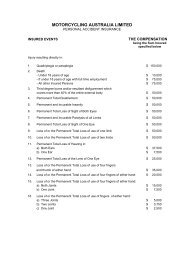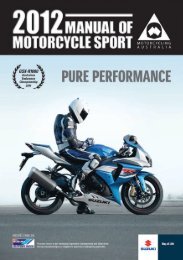2008 Manual of Motorcycle Sport - Motorcycling Australia
2008 Manual of Motorcycle Sport - Motorcycling Australia
2008 Manual of Motorcycle Sport - Motorcycling Australia
Create successful ePaper yourself
Turn your PDF publications into a flip-book with our unique Google optimized e-Paper software.
as quick as possible. If you can, plan ahead to make<br />
sure there is ample parking for your group.<br />
ride ready…on- & <strong>of</strong>f-road<br />
The <strong>Motorcycle</strong> Safety Foundation recommends<br />
you do a short pre-ride check before every ride. To<br />
help you remember the checks, the MSF came up<br />
with the acronym ‘T-CLOCK’, which stands for:<br />
• Tyres,<br />
• Controls,<br />
• Lights,<br />
• Oil,<br />
• Chassis and<br />
• Kickstand (Sidestand)<br />
These are simple, easy-to-access items that<br />
anyone who rides on or <strong>of</strong>f road should be able to<br />
identify and check. Doing the checks should only<br />
take a few minutes, but, depending on what you<br />
find, they could be the most important few minutes<br />
<strong>of</strong> your life.<br />
tyres and wheels<br />
Since tyres are where you and the road or trail<br />
meet, they’re the most important things to check. A tyre<br />
problem can affect handling—sometimes severely.<br />
Start with the pressure in both tyres. The only<br />
accurate way to check tyre pressure is when they’re<br />
cold, as they heat up quickly on the move, raising<br />
the pressure. Read your owner’s manual or check<br />
the tyre sticker.<br />
While you’re down there, make sure you’ve got<br />
plenty <strong>of</strong> tread. You should have more than 1.6 mm.<br />
Remove foreign objects that may have lodged in the<br />
treads, and make sure there aren’t any cuts in the<br />
tyre. A scuff is nothing to be worried about, but if it’s<br />
a deep scratch or a crack, you might want to have<br />
it checked.<br />
Are your rims free <strong>of</strong> dents? Are your spokes tight<br />
and straight?<br />
controls and cables<br />
A snapped throttle or clutch cable can leave you<br />
on the side <strong>of</strong> the road or stranded in the bush, so<br />
check ‘em. Operate anything connected to a cable<br />
and make sure that the levers feel smooth and there<br />
are no tight spots.<br />
Apply the front brake and push the bike forward.<br />
The brake lever should feel firm and not come back<br />
so far it touches the handlebar, and the front wheel<br />
should not move. Check the rear brake, too.<br />
lights<br />
enjoy the ride<br />
Seeing and being seen are two great ways to<br />
avoid crashes on the road or trail, so making sure<br />
your lights work is essential. Do the high and low<br />
beam work? Does the tail and brake light come on?<br />
Check left and right indicators, front and rear. Lastly,<br />
don’t forget your horn.<br />
oil and fuel<br />
Running out <strong>of</strong> fuel sucks, and since many<br />
motorcycles don’t have fuel gauges, it’s a real<br />
possibility. Pop the cap and visually check the<br />
fuel level. Make sure your fuel tap isn’t on reserve<br />
which could leave you with a nasty surprise if you<br />
roll to a stop thinking you’ve still got fuel in reserve.<br />
Keeping track <strong>of</strong> fuel can be as easy as resetting<br />
the tripmeter every time you fill up.<br />
Running out <strong>of</strong> fuel can be inconvenient, but<br />
running out <strong>of</strong> oil can turn your bike into an inert<br />
display <strong>of</strong> public art. Even new bikes can use<br />
enough oil to cause a seizure, so check it before<br />
every ride.<br />
chassis<br />
Though adjusting the suspension may not seem<br />
to be critical, different loads can cause any bike to<br />
feel quite different. Did you adjust the suspension<br />
before carrying a friend? Has your bike been sitting<br />
in the shed for the past six months?<br />
Sit on the bike and rock it, making sure that<br />
everything moves smoothly and relatively slowly.<br />
If the front or rear end behaves like a pogo stick,<br />
a trip to your trusty mechanic should be in your<br />
immediate future.<br />
If you have adjustable suspension, remember<br />
to read your owner’s manual and adjust it for the<br />
load you’ll be carrying and the type <strong>of</strong> riding you’ll<br />
be doing.<br />
sidestand (kickstand) and centre stand<br />
Stands are handy little items—they can be what<br />
keeps your motorcycle <strong>of</strong>f the ground. Make sure<br />
they’re not cracked or bent. Check the spring or<br />
springs. Are they in place, and do they have enough<br />
tension to keep the stand(s) safely up?<br />
Don’t forget to look at the engine cut-out switch,<br />
if so equipped.<br />
If everything’s in place and operating properly,<br />
you’re done, and right to go. Enjoy your ride.<br />
<strong>2008</strong> RIDERS’ DIVISION MANUAL




